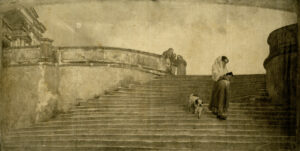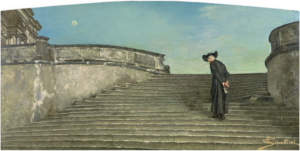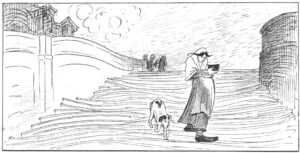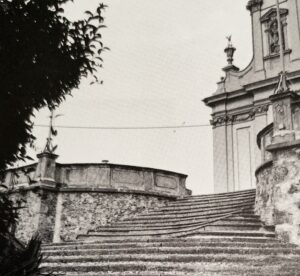Exhibitions
Non assolta — A messa prima
From the anecdotal to the symbolic
20 May — 20 October 2023, Vernissage: 30 June, 5.30 p.m.
Curated by Dr. Niccolò D’Agati and Dr. Mirella Carbone
At the centre of the special exhibition is Segantini’s famous painting A messa prima (Early Mass) from 1885. This picture was painted over an earlier work titled Non assolta (Without Absolution), which had been exhibited in Turin at the end of April 1885. Just a short while later, the new version, with the changed title was presented in Milan.
Non assolta

Non assolta
© Mart, Archivio del ‘900
The earlier painting showed a young pregnant woman leaving the church with her head bowed — the title reveals that she was not given absolution. Three older women follow the “sinner” with their — condemning? — glances. Only the dog stands by her.
The motif of the “fallen” rejected by society was very popular in the Italian iconography of the time. Did Segantini merely follow this trend, or did he, who was unable to marry his life partner, Bice, and had several children with her, also take an anti-clerical and morally critical stance with Non assolta?
A messa prima

A messa prima
We can only speculate about this question, as we can about the reasons why Segantini painted over the first version. It is known that Non assolta was largely ignored by art critics of the time, apart from a caricature published in the humorous magazine La Luna (see picture on the right). Is this why the painter decided to rework it? Or did he soon no longer like the decidedly anecdotal character of the scene? In the new version, every anecdotal element has been  eradicated: The only figure in the painting is now an old priest, in a contemplative posture, holding a half-open book with his hands clasped behind his back. A kind of ‘devotion before devotion’ with symbolic qualities. The dark figure fits more harmoniously than the earlier figures into the majestic church architecture of the scene.
eradicated: The only figure in the painting is now an old priest, in a contemplative posture, holding a half-open book with his hands clasped behind his back. A kind of ‘devotion before devotion’ with symbolic qualities. The dark figure fits more harmoniously than the earlier figures into the majestic church architecture of the scene.
An Architecture Between Verism and Free Interpretation
As the setting for the painting Non assolta Segantini chose the exterior architecture of the Baroque church of San Martino Vescovo in Veduggio (Brianza). He painted the monumental main staircase with realist precision. At the same time, however, he took the liberty of moving the church, which actually rises right where the staircase ends (see photo at right), to the left edge of the painting, so as to give the impression that the steps lead directly to heaven. This fusion of verism and free interpretation of reality also characterizes the way the painter treats the natural landscape, which he imbues with symbolic meaning.
